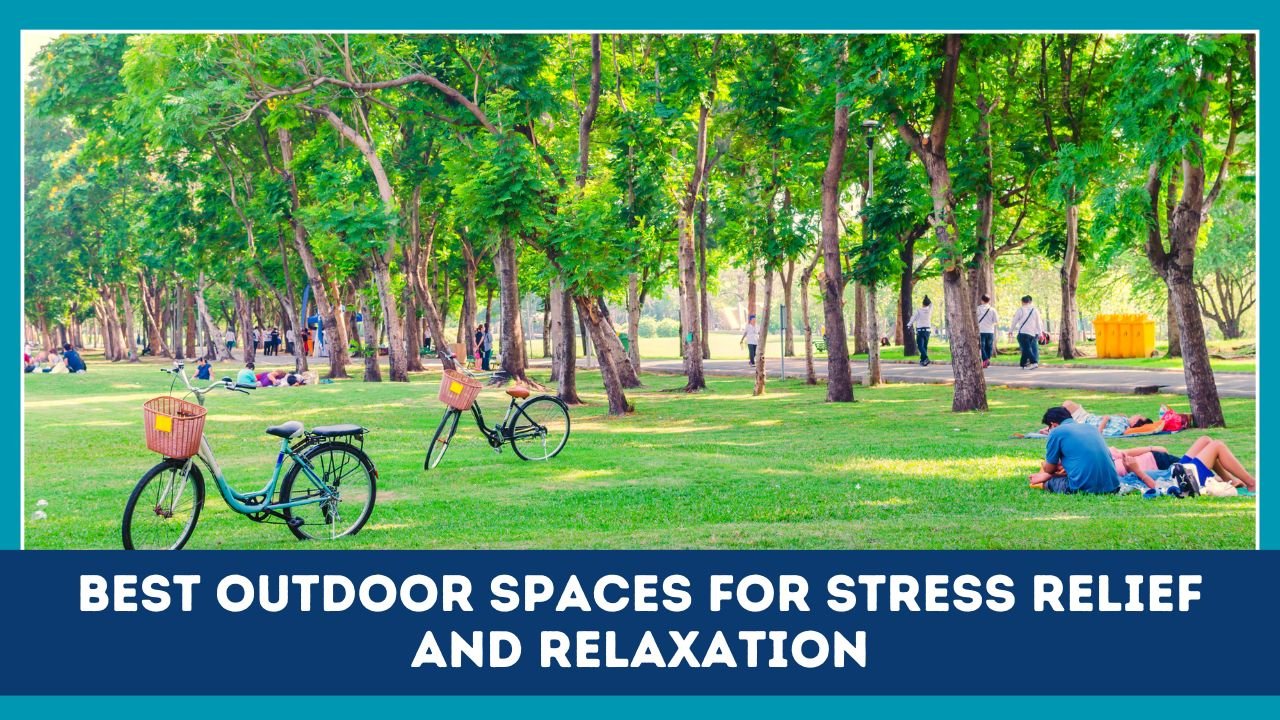In today’s fast-paced world, most people feel like they are always running out of time. Long work hours, school pressures, social media updates, and the constant noise of city life can leave us mentally drained.
This modern lifestyle of busy schedules, traffic, and endless notifications has made stress a normal part of daily living.
But the human body is not designed to stay in stress mode all the time. Our ancestors spent much of their lives outdoors—hunting, farming, walking, or simply living close to nature.
That natural connection still lives in us, and science proves that spending time outdoors is one of the most powerful, natural stress relievers available.
The good news is that you don’t need a remote mountain retreat to enjoy these benefits. Whether it’s your local park, a quiet riverside, a beach, or even a community garden, nature is always around the corner, waiting to help you slow down, breathe, and heal.
In this detailed guide, we’ll explore the best outdoor spaces for stress relief and relaxation, look at how much time outdoors really makes a difference, and share practical tips to get the most out of every moment you spend outside.
Why Nature Works for Stress Relief
1. The Science Behind Relaxation Outdoors
When you step outside, your body naturally responds to the environment around you. Just 20–30 minutes outdoors can set off a chain of positive changes:
- Cortisol drops: Cortisol is the body’s main stress hormone. Nature exposure lowers it, helping you feel calmer.
- Blood pressure and heart rate reduce: A peaceful walk outdoors can bring down these physical stress indicators.
- Better focus: Green views improve attention span and mental clarity, making it easier to concentrate later.
- Boosted wellbeing: Time outdoors lifts mood and reduces feelings of anxiety and depression.
2. The Two-Hour Rule
Experts say just 120 minutes per week in natural settings is enough to improve mood, sleep quality, and overall mental health. That’s only about 20 minutes a day—less time than most people spend scrolling on their phones.
This “two-hour rule” is not about doing something extraordinary. A small daily habit like walking in a park, relaxing in a garden, or sitting by water can add up to big improvements.
Types of Outdoor Spaces That Heal
Not all outdoor spaces feel the same. Some are filled with trees, others with water, and some with people. Each space brings its own form of peace. Let’s break down the most effective outdoor environments for stress relief.
1. Green Spaces – Parks and Gardens
Green spaces such as city parks, botanical gardens, and tree-lined boulevards are the most accessible places for stress relief.
- What makes them special? The natural green color of leaves is soothing to the eyes and helps the brain relax.
- Activities you can try: Walking, reading a book on a bench, yoga, or mindful stretching.
- Quick example: Even a 20-minute lunch break walk in a nearby park can refresh your mind before heading back to work or school.
2. Blue Spaces – Lakes, Rivers, and Beaches
Blue spaces are unique because water naturally calms the human brain. Scientists say the sound of flowing water triggers relaxation responses similar to meditation.
- What makes them special? The gentle waves, rippling water, or even fountains bring peace.
- Activities you can try: Walking by a lake, sitting by a fountain, paddle boating, or simply listening to the sound of waves.
- Quick example: A weekend beach trip or even an evening walk along a city canal can feel like a mini-vacation.
3. Forest Trails and Nature Reserves
Spending time in forests, also called forest bathing (shinrin-yoku in Japan), is a deep way to relax.
- What makes them special? Tall trees, filtered sunlight, and birdsong surround you, reducing mental fatigue.
- Activities you can try: Hiking, camping, guided forest meditation, or silent walking.
- Quick example: A monthly forest walk not only lowers stress but can also strengthen your immune system.
4. Community Gardens and Backyards
If you live in a city, community gardens are small pockets of green that bring people together. Gardening is both physical and calming.
- What makes them special? They combine nature with social connection, which doubles stress relief.
- Activities you can try: Planting flowers, watering plants, or joining a gardening club.
- Quick example: Even tending a few potted plants on your balcony gives you a daily outdoor ritual.
5. Mountain and Hilltop Views
High places give you fresh air and wide views, which help release tension and give perspective.
- What makes them special? Standing on a hilltop makes problems feel smaller and gives a sense of achievement.
- Activities you can try: Hiking, sunrise watching, or photography.
- Quick example: A weekend hike to a nearby hill can refresh your entire week.
How Long Should You Spend Outdoors?
Different outdoor spaces offer different levels of relaxation. Here’s a detailed table for easy planning:
| Outdoor Space | Ideal Time | How Often | Stress Relief Benefit | Best Activities |
|---|---|---|---|---|
| Pocket Park / Small Garden | 20–30 min | 3× per week | Lowers cortisol, clears mind | Walk, read, stretch |
| Waterfront (Lake/River/Beach) | 30–60 min | Weekly | Calms anxiety, improves mood | Walk, sit quietly, meditate |
| Forest / Nature Reserve | 1–2 hours | Monthly | Boosts immunity, deep relaxation | Hiking, camping, meditation |
| Community Garden | 30–45 min | Weekly | Combines relaxation + social bonding | Gardening, group activity |
| Mountain / Hilltop | 1–2 hours | Monthly | Clears perspective, reduces stress load | Hiking, photography |
| Urban Rooftop or Terrace | 15–20 min | Daily | Quick mood boost, helps focus | Yoga, morning tea |
How to Make the Most of Outdoor Time
Simply being outdoors is good, but the way you use the time can multiply the benefits.
- Practice mindful breathing – Inhale deeply, exhale slowly, and sync your breath with natural sounds.
- Ground yourself – Notice what you see, hear, and feel. This breaks the cycle of stressful thoughts.
- Walk slowly – Forget about speed. A relaxed pace helps the brain shift into calm mode.
- Unplug technology – Switch off notifications to let your brain rest fully.
- Track weekly time – Aim for at least 120 minutes per week outdoors.
Benefits Beyond Stress Relief
Outdoor time gives more than just peace of mind. The long-term health rewards are impressive:
- Better sleep quality because natural light resets your body clock.
- Improved immunity thanks to fresh air and reduced stress hormones.
- Sharper focus and productivity after returning indoors.
- Enhanced creativity since your brain relaxes and makes new connections.
- Reduced risk of burnout by breaking the stress cycle.
Outdoor Culture Around the World
Different cultures have long traditions of connecting with nature for peace:
- Japan: “Shinrin-yoku” or forest bathing is a recognized wellness practice.
- Nordic countries: “Friluftsliv” (open-air life) is about spending time outdoors daily, no matter the weather.
- India: Morning yoga in parks is a centuries-old routine combining movement, meditation, and nature.
- Mediterranean regions: Evening seaside walks are part of daily community life.
These traditions remind us that nature therapy is universal, not a new trend.
Simple Outdoor Routine You Can Try
To build a stress-free routine, start small and stay consistent:
- Find your local base – Pick the nearest park, riverside, or terrace.
- Start with 20 minutes three times a week – Treat it like an appointment.
- Add a weekend blue-space visit – Walk by water or spend time at the beach.
- Plan a monthly forest or mountain trip – This deeper nature reset balances urban stress.
- Track your progress – Use a journal or app to note time spent outdoors and how you feel after.
Stress may be a natural part of modern life, but the solution doesn’t always come from expensive therapies, gadgets, or complicated routines.
The most effective remedy has always been right outside your door—nature. Parks, riversides, gardens, forests, and mountains are more than just scenic backdrops; they are living spaces that can heal the mind, refresh the body, and restore balance.
Whether it’s a 20-minute walk in a nearby park during your lunch break, an hour sitting by a lakeside watching ripples on the water, or a monthly forest hike that reconnects you with the earth, these outdoor experiences are proven to reduce stress, lift your mood, and improve your overall wellbeing.
The key is consistency. Just 120 minutes outdoors per week—spread across small daily sessions and longer weekend visits—can transform your mental clarity, improve sleep, boost focus, and strengthen your long-term health. Unlike modern quick fixes, nature is free, timeless, and always available.
Think of it as the world’s oldest medicine. Step outside, breathe deeply, listen to the sounds around you, and let the outdoors gently guide you back to peace.
FAQs
Do small parks really help with stress relief?
Yes. Even a small urban park or green corner can lower stress and refresh your mind if you visit regularly.
Which is better for stress—green spaces or blue spaces?
Both are effective. Green spaces calm through trees and plants, while blue spaces add the soothing power of water.
How much time outdoors do I really need per week?
At least 120 minutes weekly is recommended. You can spread it across daily walks, weekend visits, and monthly nature trips.

